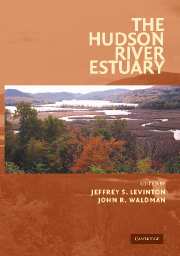Book contents
- Frontmatter
- Contents
- Preface
- List of Contributors
- The Hudson River Estuary
- 1 The Hudson River Estuary: Executive Summary
- GEOLOGICAL, PHYSICAL, AND CHEMICAL SETTING OF THE HUDSON
- PRIMARY PRODUCTION, MICROBIAL DYNAMICS, AND NUTRIENT DYNAMICS OF THE HUDSON
- 8 Bacterial Abundance, Growth, and Metabolism in the Tidal Freshwater Hudson River
- 9 Primary Production and Its Regulation in the Tidal-Freshwater Hudson River
- 10 Wastewater and Watershed Influences on Primary Productivity and Oxygen Dynamics in the Lower Hudson River Estuary
- 11 Modeling Primary Production in the Lower Hudson River Estuary
- HUDSON RIVER COMMUNITIES, FOOD WEBS, AND FISHERIES
- CONTAMINANTS AND MANAGEMENT ISSUES OF THE HUDSON RIVER ESTUARY
- Index
- Plate section
- References
11 - Modeling Primary Production in the Lower Hudson River Estuary
Published online by Cambridge University Press: 06 January 2010
- Frontmatter
- Contents
- Preface
- List of Contributors
- The Hudson River Estuary
- 1 The Hudson River Estuary: Executive Summary
- GEOLOGICAL, PHYSICAL, AND CHEMICAL SETTING OF THE HUDSON
- PRIMARY PRODUCTION, MICROBIAL DYNAMICS, AND NUTRIENT DYNAMICS OF THE HUDSON
- 8 Bacterial Abundance, Growth, and Metabolism in the Tidal Freshwater Hudson River
- 9 Primary Production and Its Regulation in the Tidal-Freshwater Hudson River
- 10 Wastewater and Watershed Influences on Primary Productivity and Oxygen Dynamics in the Lower Hudson River Estuary
- 11 Modeling Primary Production in the Lower Hudson River Estuary
- HUDSON RIVER COMMUNITIES, FOOD WEBS, AND FISHERIES
- CONTAMINANTS AND MANAGEMENT ISSUES OF THE HUDSON RIVER ESTUARY
- Index
- Plate section
- References
Summary
abstract Mathematical models are useful tools for quantifying primary production. The evolution of mathematical modeling of eutrophication toward the understanding and management of nutrients and primary production includes successively more complex and sophisticated mathematical formulations which account for the interactions between light, nutrients, and phytoplankton. Application of modern eutrophication models to the management of the Hudson River Estuary requires linkage among the New York/New Jersey (NY/NJ) Harbor Estuary, the New York Bight, and Long Island Sound. The development and application of the System-Wide Eutrophication Model (SWEM) is an example of how primary production in the Hudson River Estuary can be studied from both a cause and effect and a systemwide perspective. SWEM results show that primary productivity in the Lower Hudson River Estuary and contiguous waterways, with the exception of western Long Island Sound and portions of Raritan Bay, is controlled by the availability of light and residence time rather than nutrients. SWEM results also show that both nitrogen and carbon contribute to dissolved oxygen deficit but the relative importance of each is quite dependent upon specific location and the interrelationship of a number of physical, chemical, and biological variables. It is due to these complexities that mathematical modeling becomes an effective technique in understanding the process of primary production in the Lower Hudson.
Introduction
The purpose of this chapter is to describe how mathematical models may be applied to increase the understanding of primary production. The main points of this chapter include:
An overview of primary production in natural water systems;
[…]
- Type
- Chapter
- Information
- The Hudson River Estuary , pp. 140 - 154Publisher: Cambridge University PressPrint publication year: 2006
References
- 2
- Cited by



